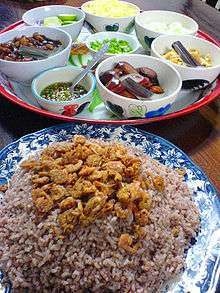Khao khluk kapi

Khao khluk kapi (Thai: ข้าวคลุกกะปิ, pronounced [kʰâːw kʰlúk kāpìʔ]; sometimes spelled as khao kluk kapi) is a flavorful dish in Thai cuisine that consists of primary ingredients of fried rice mixed with shrimp paste, the latter of which is known as "kapi" in Thai.[1][2][3][4][5] The dish is typically served with several side dishes or toppings, such as sliced cucumber, sliced shallot, onion or purple onion, deep-fried or fried shrimp, shredded or thinly sliced sour green mango, chili peppers, deep-fried chili peppers, sliced thin egg omelet or crêpe, sweetened roasted pork, pork belly (Chinese mu wan), Chinese sausage such as kun chiang, and mackerel, among others.[1][2][3][4][6]
It has been described as a salad dish per the vegetables that accompany the dish, and as possessing the flavors of saltiness per the shrimp paste, sweetness per the fruits, and spiciness, per the chili peppers.[3][6]
History
Khao khluk kapi originated in Central Thailand, and it is typically served as a lunch dish in Thailand.[3] Foreign visitors to Thailand may not be aware of the dish's existence.[1][3]
See also
References
- 1 2 3 "7 món cơm bình dân nhưng ngon 'không chê vào đâu được' của châu Á". Việt Times Australia (in Vietnamese). April 6, 2017. Retrieved April 25, 2017.
- 1 2 Ferber, Lawrence (March 7, 2016). "The One Thing Visitors to Thailand Should Know About Ordering Food". CNT. Retrieved April 25, 2017.
- 1 2 3 4 5 Bush, Austin (January 4, 2010). "Khao khluk kapi: The best Thai dish you've never heard of". CNN Travel. Retrieved April 25, 2017.
- 1 2 Philpott, D. (2016). The World of Wine and Food: A Guide to Varieties, Tastes, History, and Pairings. Rowman & Littlefield Publishers. p. 452. ISBN 978-1-4422-6804-3.
- ↑ Journal of the National Research Council of Thailand (in Thai). The Council. 2003.
- 1 2 "Gallery: 10 Overlooked Thai Dishes in Chicago from Leela Punyaratabandhu of 'SheSimmers': Serious Eats". Serious Eats. April 20, 2017. Retrieved April 25, 2017.